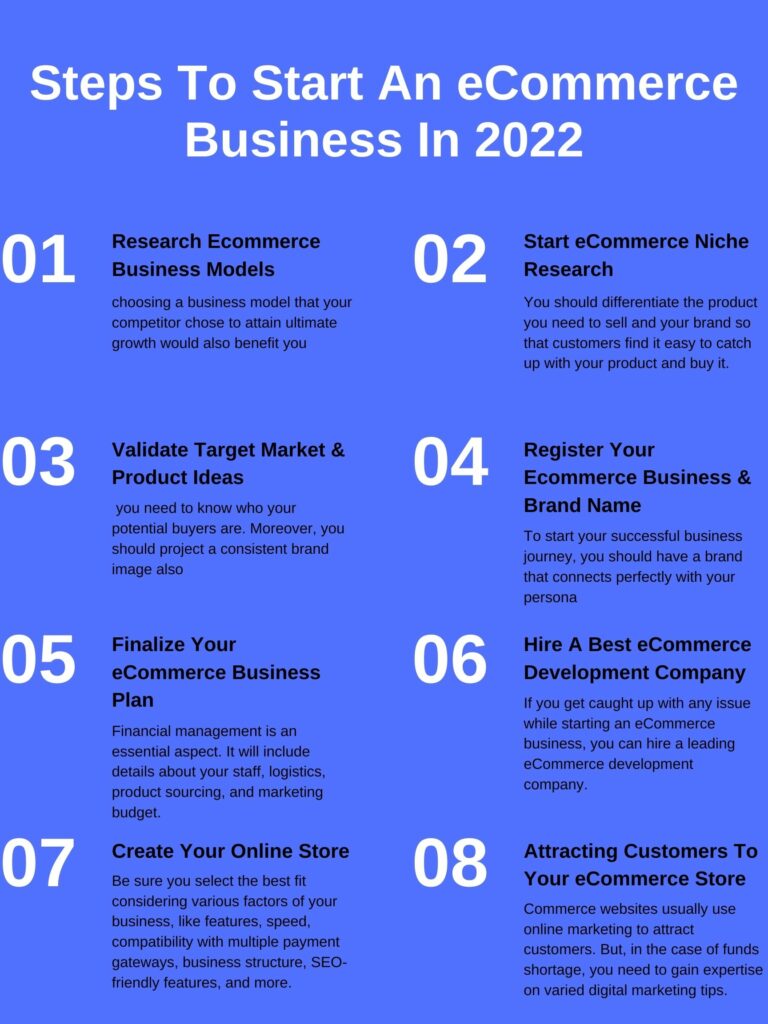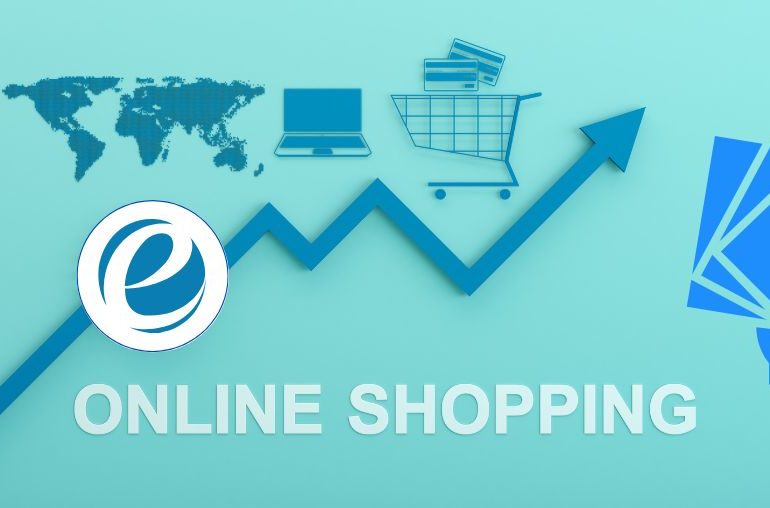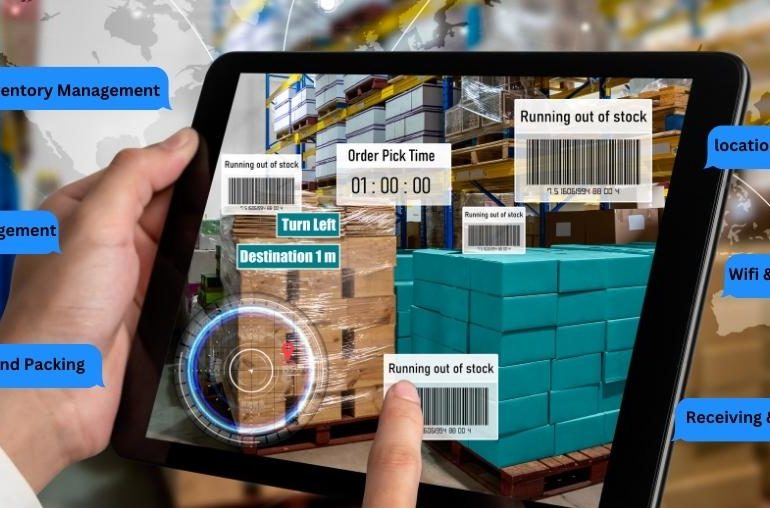Last Updated on November 24, 2022
Obviously, it’s not easy to start an eCommerce business as it demands finalizing varied decisions and following distinct steps towards meeting the expected outcomes.
Before discussing further, let’s understand eCommerce better.
An eCommerce is an online process of selling and buying goods and services. The best thing about an ecommerce startup is that one can update and change it the way he wants and make it engaging for the customers.
Now, We know what eCommerce is, we will next discuss the steps one needs to follow to start an ecommerce business.
Why Starting An eCommerce Business In 2022 Is A Good Idea?
Well, various factors need to be considered to start an online business in 2022.
Read on to know!
eCommerce Business Market Statistics
If we consider worldwide retail eCommerce statistics, they will also tell ditto.

In 2019, the global retail eCommerce sales figures were around $3.354 trillion.
Whereas, in 2020, it was nearly $4.28 trillion, and in 2021, it was reported approx—$ 4.891 trillion.
Furthermore, in 2022, it’s likely to reach about $5.4 trillion.
So, these stats say it all. The growth of eCommerce businesses is constantly increasing even in COVID-19 also.
So, we can say it’s the best time to kick-start an eCommerce business.
eCommerce Trends That Will Influence eCommerce Businesses

After focusing on eCommerce statistics, let’s check out the top eCommerce trends.
- Increasing use of voice search.
- AR is improving the reality of online shopping.
- AI assists online shops in learning about shoppers.
- Various payment modes.
- Chatbots enhance the shopping experience.
- Subscriptions make consumers, repeat customers, etc.
The stats and marketing trends uncover the expected success of starting eCommerce businesses.
What Is The Future Of Ecommerce Business?
Well, after targeting market stats and trends, we got to know every aspect that supports the decision to start an eCommerce business.
Now, we will talk about the future prospects of an eCommerce business.

Google is also coming with a new algorithm, Google’s MUM, to permit the users to perform detailed searches that the traditional search queries failed to answer.
Even this innovation allows images as an input besides just the texts, which means users would also search with a picture. Besides, this algorithm is not restricted to answering in just one language, and it’s best at answering in multiple languages to bring the most helpful answer for the users.
Google MUM is also coming to Google Lens. This will meet the MUM’s promise, according to which it will also permit the users to search with an image. It will prove to be beneficial for the eCommerce brands, like, a new sales channel for their users.
This way, the products of eCommerce companies will get found easily in Google Lens search results. They only need to upload product details to Google Merchant Center and choose free product listings following the Google Image best practices.
Pre-Steps To Follow Before Rooting An Online Business
Before jumping onto eCommerce store development steps, you need to figure out various other things. Let’s check them out.
1. Refine Your Idea
If you have an idea about a business you want to start or know something about the market you want to enter, you are all set to conduct a quick search.
Check the existing brands in your picked industry and see what they are doing and missing. Plan how you can perform those missing aspects better.
Moreover, you should know:
- Why do you want to start your business?
- Emerge with a unique and idea-recognizable name for your business.
- Clarify your prospects
2. Clear Your Business Objective
First, you need to understand what you want to achieve and your business objectives. You should make it clear and then move further. It will help you follow the best and suitable objective-specific practices that will guide your business towards success.
3. Write A Business Plan
After researching and setting your business objectives, it’s time to write a business plan.
A roadmap that will help you attract different thoughts and ideas is a business plan, and it’s essential to determine the priorities and successfully reach new customers.
For that, you need to conduct deep market research and choose an exit strategy.
A business plan assists in understanding the route of the company towards its objectives and how it will compete with potential issues.
4. Assess Your Finances
Obviously, starting a business costs an amount. So, you need to determine how you will arrange those funds. But, before that, you need to confirm how much a startup costs?
Before catching up with a profit, many startups ran out of money. You can overestimate; it will save you from such a mishap. You can:
- Monitor your business expenses.
- Find funding options and more.
5. Understand The Risk
Launching a new business always includes a level of risk, and it’s essential to understand, evaluate, and plan for risks. Before starting your business journey, this should be done following a business plan you crafted.
Steps To Start An eCommerce Business In 2022
Well, you are here to know how to start an eCommerce business. After finishing the pre-steps, let’s begin with the step-by-step guide to starting an eCommerce business.

Step 1: Research Ecommerce Business Models
The first and foremost step to start is research. It’s like an investment to grow an online business, and you also should treat it the same.
It’s not like choosing a business model that your competitor chose to attain ultimate growth would also benefit you.
So, you should start by learning about different business models available in the market.
There are four types of eCommerce business models:
- B2C – Business to consumer
- C2B – Consumer to business
- B2B – Business to business
- C2C – Consumer to consumer
An eCommerce business model that’s picked chiefly is a single product category, and one needs to boost it with affiliate marketing. It permits branding and content marketing on a targeted product and targets the remaining energy on driving sales by monetizing traffic.
Step 2: Start eCommerce Niche Research
eCommerce niches are segments that sell a particular product type with a unique differentiator in an industry. It may include anything from healthcare products or eco-friendly ones.
You should differentiate the product you need to sell and your brand so that customers find it easy to catch up with your product and buy it.
While doing that, you should make sure that your chosen area is competitive; otherwise, you may expect no market there.
Just avoid picking the niche that major brands dominate.
So, emerge with a product category holding a minimum of 1000 keywords. Also, choose the one that does well on social media, where the publishers in that area are affiliates.
Step 3: Validate Target Market & Product Ideas
Before you start searching for products you want to sell, you should think about the product ideas, personas. Also, you need to know who your potential buyers are. Moreover, you should project a consistent brand image also.
You can take the assistance of Facebook too, and it helps find your target audience online and how many people you can target.
Next, you can move further to product ideas. For that, you can start analyzing your competition, understand it, conduct an online test, craft a prototype, and pitch your idea.
Step 4: Register Your Ecommerce Business & Brand Name
To start your successful business journey, you should have a brand that connects perfectly with your persona.
For that, you need to register your business, choose a unique name for it, get its licenses, employer identification number (EIN), apply for business permits and licenses, catch up with the right vendor, craft a distinctive logo, and get the visuals.
Step 5: Finalize Your eCommerce Business Plan
Now, it’s the right time to prepare your business plan and determine your loan needs, startup budget, and monthly expenses.
Financial management is an essential aspect. It will include details about your staff, logistics, product sourcing, and marketing budget.
Furthermore, you should target the inventory management aspect also. You don’t need to store products at your warehouse to sell online, and you can just use fulfillment centers to manage your inventory.
Step 6: Hire A Best eCommerce Development Company
If you get caught up with any issue while starting an eCommerce business, you can hire a leading eCommerce development company. The company will help you with the technical flow, management, user experience, customization, technical support, mobile commerce, a captivating theme, etc.
Step 7: Create Your Online Store
Now, you can start developing your online store. For that, you need to choose an eCommerce platform. Be sure you select the best fit considering various factors of your business, like features, speed, compatibility with multiple payment gateways, business structure, SEO-friendly features, and more. You can go for BigCommerce, Shopify, Wix, etc.
While setting your online store, you also need to get your email marketing and set up your automation. These things are essential for boosting conversions. Moreover, don’t forget to consider customer support also.
Step 8: Attracting Customers To Your eCommerce Store
The keyword-stuffing days are gone, but SEO is still alive. Although you need to keep keywords and search terms on every page of your site, URLs, and advertisements, you should also concentrate on driving traffic to your store.
eCommerce websites usually use online marketing to attract customers. But, in the case of funds shortage, you need to gain expertise on varied digital marketing tips.
You can choose to run PPC ads, sponsored content, social media, etc., and adopt some ways to monitor the results of campaigns. It will bestow you an idea about the campaign which is performing best.
Besides, you can choose to offer freebies, host a giveaway, or launch a social media campaign to attract subscribers.
How Much Does It Cost To Start An eCommerce Business?

So, after reviewing the steps to start an eCommerce business. Now, we will know about the cost factor that you might also be curious to know, the cost.
Well, there’s no fixed cost of starting an eCommerce business as the price depends on various factors. Let’s check out some.
eCommerce CMS
Obviously, an open-source platform is free to download. But, other associated costs also arrive with such a solution, like hosting, developer fees, add-ons, etc.).
The basic options may cost low, but the comprehensive and advanced solutions may demand high costs.
Business Licenses & Permits
The cost of licenses and permits relies on your location, entity type, and the product you are selling, and it may increase the budget of the eCommerce business.
Domain Name & Hosting
Some eCommerce solutions come with the cost of hosting or domain name. But, some charge an extra amount for that.
Inventory & Shipping
Your inventory and shipping cost varies depending on what you are selling, the shipping services you use, the products’ size, etc.
Payment Processing
You need to consider a payment processor also for accepting payments online. Your eCommerce software solution will embrace payment processing with the platform, whereas some demand integrating the preferred system.
Advertising & Marketing
You can start using free marketing and advertising options, and once you catch up with a better idea, you can start looking for paid options for your store promotions.
Tips For Starting An eCommerce Business
By reviewing the latest eCommerce statistics, we can expect eCommerce business’s significant growth in the upcoming years. So, it’s time to follow critical tips that can ease your pathway toward a successful eCommerce business.
Let’s check them out!
- Conduct the launch of your eCommerce store seamlessly.
- Focus on attracting your customers by easing the checkout process, offering free shipping, etc.
- Invest in testing and analytics before launching.
- Hire social media manager and work closely with him.
- Include essential social elements, like testimonials, product reviews, etc.
- Go mobile.
- Hire an SEO expert to catch up with a top position on the Google search list.
- Accumulate customer information for future use.
- Keep your store updated with technology, customer tastes, and trends.
Conclusion
As eCommerce businesses are likely to earn increased revenue in the upcoming years, the interested people should also try their luck. But, for that, you need to be ready with a lot more effort and every essential aspect.
We hope this article proves to be informative for you and helps you with all the answers to your queries.





 USA
USA UK
UK Singapore
Singapore